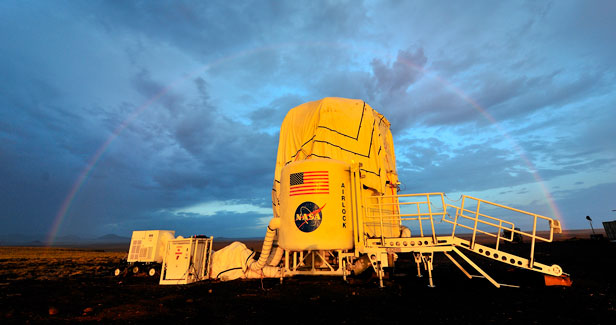NASA Tests a Versatile Habitat for Long-Term Missions

Despite recent cuts to its manned space program, NASA continues to research ways that astronauts might live safely in space during prolonged missions. The agency recently completed tests of a prototype astronaut habitation unit in the rugged, barren, almost-Martian landscape of the Arizona desert. The habitat could be tested in space within a decade, and might one day serve as a home away from home for astronauts on the moon or Mars.
The tests, completed last month, included sending in crews for overnight stays, and running simulations of work that would be done in a single day.
The current prototype housing unit has a hard cylindrical shell, contains four rooms, two outside additions for dust mitigation and hygiene, and an inflatable component that adds a second level for sleeping and relaxing.
The inflatable loft design was part of a university competition called XHab. The researchers explain that a final design could be fully inflated, or could have a small hard shell inside an inflated exterior. Hard shells, while heavier to transport, are better at blocking dangerous radiation from space.
PHOTO GALLERY:
A Deep-Space Home for Astronauts
Inflatable space habitats have been a popular idea since the 1970s, but the new project is the most advanced to date. Inflatable units are a typical option because they offer a lot of volume for the weight of materials, so the cost of getting the housing to space is lower.
The team also tested a prototype robot that could explore the surface of Mars and be controlled by an astronaut from inside the habitation.
“It changes things if you’re running that robot in close proximity, versus trying to operate it from Earth with a 50-second time delay,” says Kriss Kennedy, project manager of the Habitat Demonstration Unit project. The results were presented this week at the American Institute for Aeronautics and Astronautics (AIAA) Space 2011 conference in Long Beach, California.
The habitation system uses embedded sensors to reduce the need for checkups by crew and ground control. “We are infusing more technologies so that crew wouldn’t have to repair the unit if there were a problem. Inside the unit, the electronics can be controlled by iPads and iPhones, allowing the crew to adjust the lights and temperature.
Deep space missions are inherently risky. Radiation from galactic cosmic rays, which can cause cancer, and from solar flares, which can cause quick death, is a serious issue for long-term space habitation. Cargo bags, used to carry loads up to space, could used to change urine into water via a purification technique called forward osmosis and then help pad the walls with water to protect the crew inside.
The unit could be adapted for missions to the moon, Mars, an asteroid, or simply as a free-flying habitat in space. “Different missions require different sizes of habitation,” says Tracy Gill, who works within the Space Station Utilization Division at NASA’s Kennedy Space Center, because of the different items needed onboard. Within 10 years, the team plans to have a demonstration unit either flying in space or attached to the International Space Station.
Flying habitats need to be easy to repair, says Jeffrey Hoffman, a former astronaut and professor of aeronautics and astronautics at MIT. “Unlike the International Space Station, it won’t be possible to send up replacement parts, so local materials will be key,” he says.
Daniel Lester, an astronomer at the University of Texas at Austin, says a habitation like the one NASA is testing could be a useful place to house a crew servicing space telescopes, or assembling spacecraft to travel to farther-off places like Mars.
Keep Reading
Most Popular
Large language models can do jaw-dropping things. But nobody knows exactly why.
And that's a problem. Figuring it out is one of the biggest scientific puzzles of our time and a crucial step towards controlling more powerful future models.
How scientists traced a mysterious covid case back to six toilets
When wastewater surveillance turns into a hunt for a single infected individual, the ethics get tricky.
The problem with plug-in hybrids? Their drivers.
Plug-in hybrids are often sold as a transition to EVs, but new data from Europe shows we’re still underestimating the emissions they produce.
Stay connected
Get the latest updates from
MIT Technology Review
Discover special offers, top stories, upcoming events, and more.